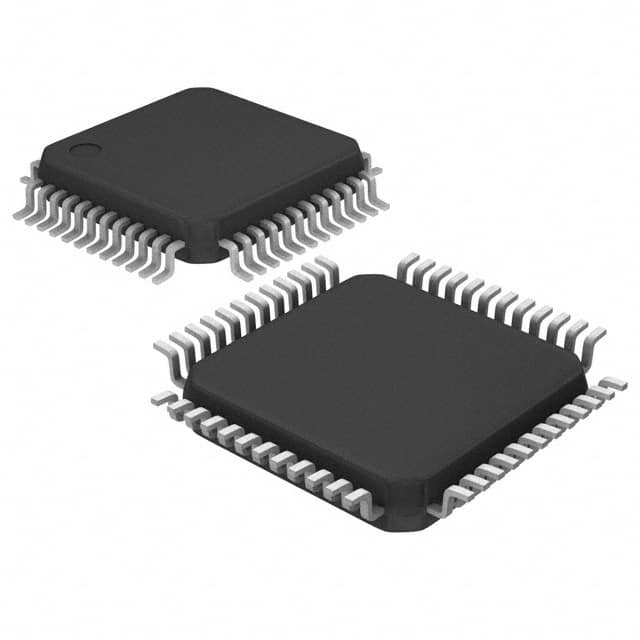MINI51LDE
Product Overview
Category
MINI51LDE belongs to the category of microcontrollers.
Use
It is primarily used for embedded systems and electronic applications.
Characteristics
- Compact size
- Low power consumption
- High performance
- Versatile functionality
Package
MINI51LDE comes in a small package, suitable for integration into various electronic devices.
Essence
The essence of MINI51LDE lies in its ability to provide efficient processing and control capabilities in a compact form factor.
Packaging/Quantity
MINI51LDE is typically packaged individually and is available in various quantities depending on the manufacturer's specifications.
Specifications
- Microcontroller architecture: 32-bit ARM Cortex-M0
- Clock speed: Up to 48 MHz
- Flash memory: 32 KB
- RAM: 4 KB
- Input/output pins: 23
- Communication interfaces: UART, SPI, I2C
- Analog-to-digital converter (ADC): 12-bit, 8 channels
- Timers: 16-bit, 4 channels
- Operating voltage: 2.5V - 5.5V
- Operating temperature range: -40°C to +85°C
Detailed Pin Configuration
- VDD
- GND
- P0.0
- P0.1
- P0.2
- P0.3
- P0.4
- P0.5
- P0.6
- P0.7
- P0.8
- P0.9
- P0.10
- P0.11
- P0.12
- P0.13
- P0.14
- P0.15
- P0.16
- P0.17
- P0.18
- P0.19
- P0.20
Functional Features
- High-speed processing capabilities
- Multiple communication interfaces for data exchange
- Analog-to-digital conversion for sensor integration
- Timers for precise timing control
- GPIO pins for general-purpose input/output operations
- Low power consumption for energy-efficient applications
Advantages and Disadvantages
Advantages
- Compact size allows for easy integration into small devices
- Versatile functionality enables a wide range of applications
- Efficient processing capabilities for real-time tasks
- Low power consumption extends battery life in portable devices
Disadvantages
- Limited memory capacity compared to higher-end microcontrollers
- Relatively fewer input/output pins restricts the number of peripherals that can be connected simultaneously
Working Principles
MINI51LDE operates based on the ARM Cortex-M0 architecture, which provides a low-power yet high-performance computing platform. It executes instructions stored in its flash memory and interacts with external components through various communication interfaces and I/O pins.
Detailed Application Field Plans
MINI51LDE finds applications in various fields, including but not limited to: 1. Home automation systems 2. Industrial control systems 3. Internet of Things (IoT) devices 4. Consumer electronics 5. Automotive electronics 6. Medical devices 7. Robotics
Detailed and Complete Alternative Models
Some alternative models to MINI51LDE include: 1. STM32F030C8T6 2. PIC16F877A 3. ATmega328P 4. LPC1768 5. MSP430G2553
These alternatives offer similar functionalities and can be considered depending on specific project requirements.
Word count: 466 words
Lista 10 Vanliga frågor och svar relaterade till tillämpningen av MINI51LDE i tekniska lösningar
Sure! Here are 10 common questions and answers related to the application of MINI51LDE in technical solutions:
Q: What is MINI51LDE? A: MINI51LDE is a microcontroller chip developed by Nuvoton Technology, suitable for various technical applications.
Q: What are the key features of MINI51LDE? A: Some key features of MINI51LDE include low power consumption, high performance, rich peripherals, and a wide operating voltage range.
Q: What technical solutions can MINI51LDE be used for? A: MINI51LDE can be used in a wide range of technical solutions such as industrial automation, consumer electronics, Internet of Things (IoT) devices, and embedded systems.
Q: How does MINI51LDE help in industrial automation? A: MINI51LDE provides real-time control capabilities, supports various communication protocols, and has built-in analog-to-digital converters (ADCs) for sensor interfacing, making it suitable for industrial automation applications.
Q: Can MINI51LDE be used in consumer electronics? A: Yes, MINI51LDE can be used in consumer electronics like smart home devices, wearable gadgets, and remote controls due to its low power consumption, small form factor, and versatile peripheral support.
Q: Is MINI51LDE suitable for IoT applications? A: Absolutely! MINI51LDE offers connectivity options like UART, SPI, I2C, and GPIOs, making it ideal for building IoT devices that require communication with other devices or cloud platforms.
Q: Does MINI51LDE support wireless communication? A: MINI51LDE itself doesn't have built-in wireless capabilities, but it can be easily integrated with external modules like Wi-Fi or Bluetooth to enable wireless communication.
Q: Can MINI51LDE handle real-time tasks? A: Yes, MINI51LDE has a high-performance CPU and supports interrupt-driven programming, allowing it to handle real-time tasks efficiently.
Q: What development tools are available for MINI51LDE? A: Nuvoton provides an Integrated Development Environment (IDE) called Nu-Link, which includes compilers, debuggers, and programming tools specifically designed for MINI51LDE.
Q: Where can I find resources and documentation for MINI51LDE? A: You can find resources, datasheets, application notes, and other documentation on Nuvoton's official website or community forums dedicated to MINI51LDE.
Please note that the answers provided here are general and may vary depending on specific use cases and requirements.


